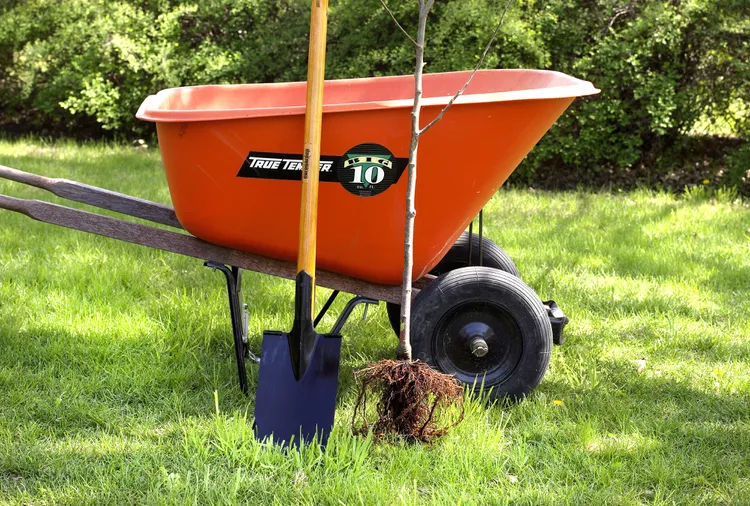Many types of trees such as apples and oaks are sold as bare root trees. Before investing in one, it's important to know that planting a bare root tree is a little different than planting a tree growing in a pot. A bare root tree requires a little special care but they offer several advantages that make them a smart choice. Here's what to know about bare root trees to successfully grow them and the essential steps to follow to properly plant one in your yard.
What Is a Bare Root Tree?
Rather that growing in a pot, bare root trees are exactly what they sound like—a mass of bare, or soilless, roots below a sturdy trunk and bare branches. Grown in a nursery field and dug up in early spring before their leaves emerge, bare root trees are delivered to your local garden center or shipped to your door at the best planting time. Their minimal weight and general ease of handling makes bare root trees less expensive than similar sized trees in growing in containers.
What to Do Before Planting
How you care for bare root trees before they are planted in the landscape is just as critical as their after-planting care. Bare root trees are harvested and shipped while they are still in their winter dormancy. The key to success is keeping the trees in this dormant state until they are ready for planting. Adequate moisture and just-right cool temperatures keep trees dormant.
If possible, plant bare root trees as soon as you receive them. These trees are stored in huge refrigerators at the mail order nursery or your local nursery before you receive them. The short transition time from the refrigerator to your house has likely spurred the trees to begin growing. Aim to get the trees in the ground right away.
If weather conditions or life circumstances prevent immediate planting, store your bare root tree at 40°F. An unheated garage or root cellar might be a good storage place. Keep the trees wrapped in moist, but not wet, packing material. Mail order trees can remain in their shipping material. Locally purchased trees can be wrapped in moistened newspaper. Do not allow the trees to dry out.
How to Plant Bare Root Trees
Planting bare root trees is easy to do, but there are essential steps to follow for success. These include hydrating the trees before planting and then establishing the proper planting depth.
1. Begin with a soak.
Soak tree roots in a bucket of water for one or two hours. Any longer than two hours and the roots can become depleted of oxygen so set a timer. While the tree is soaking, prune off any broken or damaged branches.
2. Dig a planting hole.
When you are ready to plant your bare root tree, dig a hole that is two times as wide as the tree’s root system. The depth of your planting hole is determined by the distance from the tree’s trunk flare—the swelling at the base of the trunk where roots emerge—to the bottom of the tree’s roots.
The best planting hole cannot overcome a poor planting location. Match the tree’s preferred growing conditions with the ideal spot in your landscape. And don't forget to take the mature size of the tree into account. A 4-foot-tall bare root maple tree will mature into a tree that is 30 feet tall or more and potentially as wide.
3. Make a cone in the center of the hole.
Using excavated soil, create a cone-shaped mound in the center of the planting hole. The mound of soil will support the tree's roots. Place the tree on the top of the mound, spreading the roots over the soil. The trunk flare—the swelling at the base of the trunk where the roots begin to emerge—should be even with the soil surface. Adjust the soil mound as needed.
4. Backfill with soil from the planting hole.
Fill in around your bare root tree with the excavated soil, firming it around the tree’s roots as you go. Don't add compost or other amendments.
5. Build a shallow basin and add mulch.
Using your garden soil, build a 3-inch-tall ring around the root zone to form a shallow basin. This ring will help hold water so it can slowly soak into the root zone. Spread a 2-inch-thick layer of mulch over the root zone, making sure the mulch doesn't touch the trunk of your tree.
6. Add a stake.
Newly planted bare root trees frequently need a stake to stabilize them until they can grow new roots. Sink a sturdy wood or metal stake two to three feet into the undisturbed soil outside the tree’s root zone. Use strong, wide strips of canvas or rubber to support the tree. Remove the staking material in the second growing season.
7. Provide plenty of water.
Finally water your newly planted tree deeply. Provide about 5 gallons of water at planting time, delivered slowly so water has time to soak down into the soil. Then, check the tree once or twice a week and water it when the soil around the roots is dry. Supplemental watering is usually needed through the first growing season. Continue watering in year two and three if conditions are dry.




















